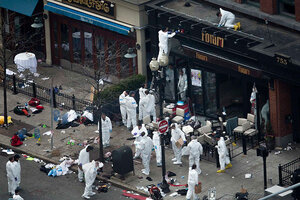Boston Marathon bombs made with pressure cookers: Big break in case?
Reports suggest that the devices in the Boston Marathon bombings were put in pressure cookers. That suggests the bombs were unsophisticated, but experts warn against rushing to judgment.

Officials take crime scene photos a day after two explosions hit the Boston Marathon in Boston Monday.
Shannon Stapleton/Reuters
WASHINGTON
The explosive devices used in the Boston Marathon bombings, as well as the crime scene itself, will be the “epicenter” of the massive investigation into who carried out Monday’s deadly attack.
But information that the bombs reveal might not be enough to crack the case, and could even lead in wrong directions or to mistaken conclusions. Given the lack of any intelligence leading up to the marathon suggesting that an attack might be imminent, experts suggest that investigators will have to be particularly patient and painstaking, despite the national desire for a quick break in the case.
By Tuesday afternoon, for example, investigators said that pressure cookers had been used to encase the explosive devices – a rather crude method of construction that might suggest the involvement of an amateur "lone wolf" or point in the direction of domestic extremists.
But Islamist extremists in France tried to use pressure cookers last year in what officials there said could have been the biggest terror attack on French soil in years, until it was foiled. Likewise, US Army Pfc. Naser Abdo, who was convicted in 2012 of plotting to bomb a Texas restaurant where Fort Hood soldiers regularly ate, got the recipe for a pressure cooker bomb from an Al Qaeda website.
As far back as 2004, the US Department of Homeland Security was warning about pressure cooker bombs. In 2010, it issued an advisory warning about the use of pressure cookers, from Afghanistan to Malaysia, in the construction of improvised explosive devices (IEDs).
“After so many years of doing this, [Al Qaeda operatives] have sophisticated bombmakers and bombmaking methods. The assumption would be that, the more sophisticated [the device], the more likely it’s foreign terrorism,” says Mark Ensalaco, a terrorism expert at the University of Dayton in Ohio.
But seasoned terrorists would know that favored bombmaking ingredients like C4 and fertilizer are difficult to accumulate surreptitiously. “So they could have said, ‘We know they’re going to be looking for a bomb of that type, so we’re going to build a different type they won’t be expecting.' ” he adds
Reports Tuesday afternoon said that timing devices, not cell phones, were used to detonate the bombs. That could suggest that the bombers sought to avoid leaving a communications trail, some experts say. A call to detonate the bombs would have registered at a nearby cell tower.
But a timing device, if enough pieces can be reassembled, can also provide evidence that leads to the perpetrators, says Mr. Ensalaco. That is why even the smallest bits of evidence can end up being crucial, and why the public should treat any shred of information as potentially helpful, he adds.
One bit of recovered plastic led to the breakthrough in the investigation of the Pan Am Flight 103 bombing, which was carried out by Libyan intelligence officials under Muammar Qaddafi in 1988. [Editor's note: The timing of the investigation has been corrected.]
“Evidence was spread over hundreds of square miles, but investigators were able to find a piece of computer circuitry branded into a cell tower,” says Ensalaco. “From there, they traced that piece to Libyan intelligence.”
For that reason, investigators of the Boston Marathon bombings are asking the public to come forward with any evidence from the crime scene and its environs – perhaps a cellphone video taken the day before, a snapshot of friends taken at the Starbucks near the attack’s ground zero, or a recollection of a backpack lying unattended on the sidewalk – no matter how inconsequential the information may seem.
The investigation, which is being led by the FBI but which involves a large number of local, state, and federal agencies, will be looking for the one piece of the mosaic that alone may seem unremarkable, but which, when placed in context, will allow other pieces to fall into place, terrorism experts say.
“We have received voluminous tips in the last 18 hours,” said Richard DesLauriers, the special agent in charge of the FBI’s Boston office, at a morning news conference in Boston. “We strongly encourage that assistance to continue.”
Also Tuesday morning in Washington, President Obama commented publicly for the second time on the bombings, calling them unequivocally an “act of terror” but cautioning the public that finding the terrorists who committed the act could take time.
“Any time bombs are used to target innocent civilians, it is an act of terror,” Mr. Obama said at the White House. “What we do not know yet, however, is who carried out this act or why – whether it was planned and executed by a terrorist organization, foreign or domestic, or was the act of a malevolent individual. That is what we do not yet know, and clearly we are at the beginning of our investigation.”
Investigators will be working to crack the case – and reassure a jittery public – as quickly as possible, experts add. But they also note that past experience from other terror attacks will make getting things right as important – or more so – than solving things fast.
The 1996 Centennial Olympic Park bombing at the Atlanta Summer Olympics got on the wrong track when a security guard was quickly accused of planting a package bomb. It would be years before the actual bomber, Eric Robert Rudolph, a far-right extremist, was caught and brought to justice.

